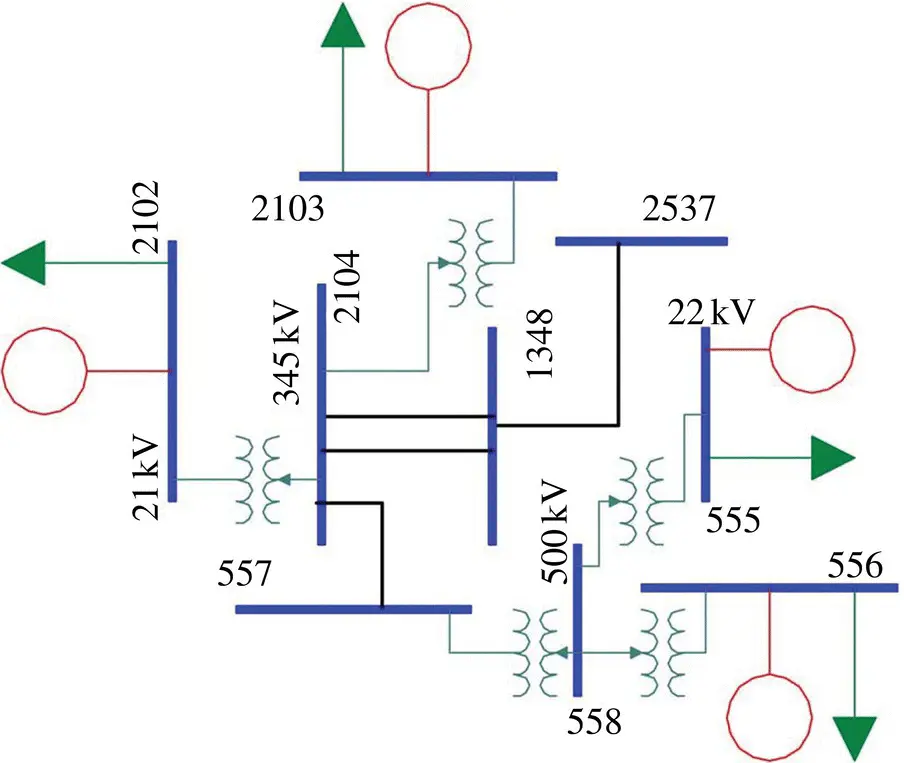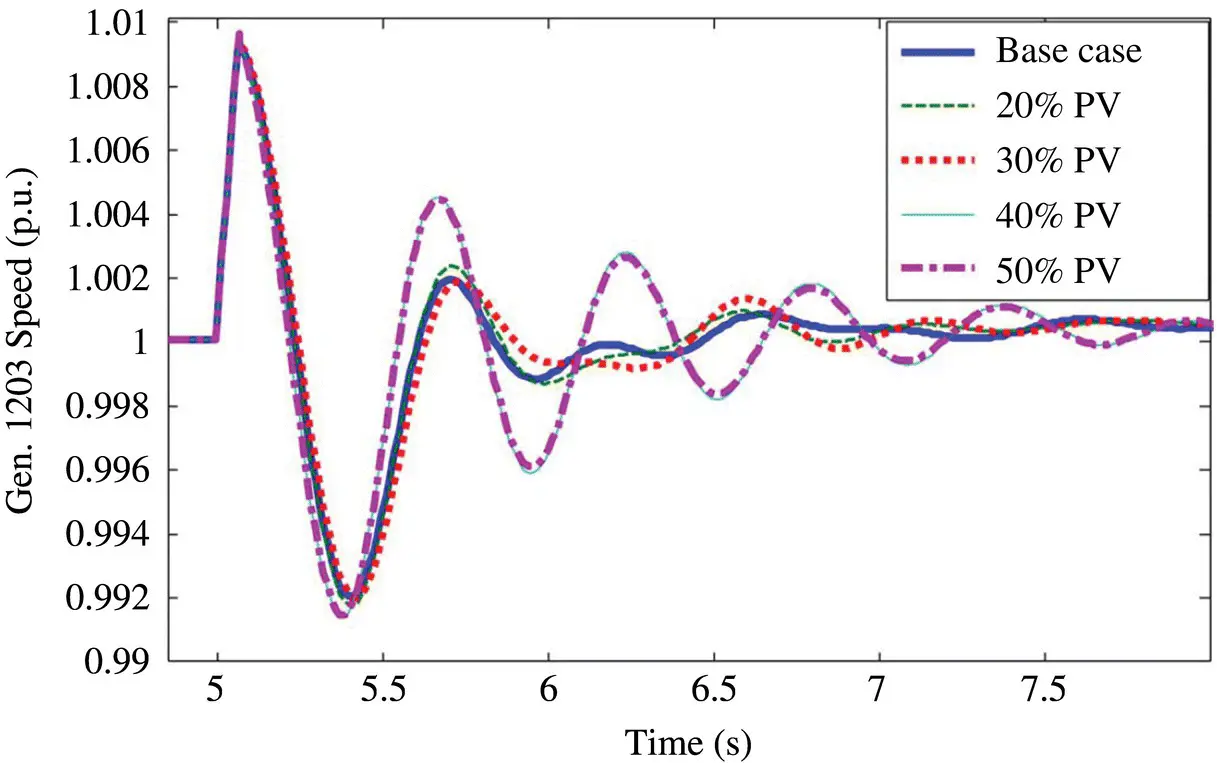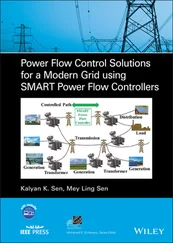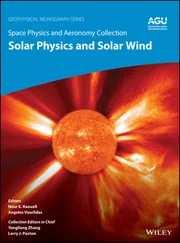Critical electromechanical modes having a damping less than 10% are obtained from Eigen analysis. The variation of damping ratio of this system mode with increasing solar PV penetration is illustrated in Table 1.1[87]. It is seen that increasing PV penetration has a detrimental impact on the damping of the critical electromechanical mode.
The generators having highest participation in this critical mode are identified through participation factor analysis. A single‐line diagram of the region close to these generators which are connected at buses 2102 and 2103 is depicted in Figure 1.18[87].
A three‐phase fault at 345 kV bus numbered 2104 is initiated for four cycles. The speed of generator located at bus 2103 is portrayed in Figure 1.19[87].
Clearly, the speed of this generator becomes more oscillatory with increasing solar PV penetration, i.e. with increasing displacement of conventional synchronous generators. It is, therefore, recommended that when solar PV penetration levels are likely to increase in a system, critical generators must be identified and still kept in service to maintain adequate damping levels of the critical electromechanical modes.
Table 1.1 Impact of PV penetration on damping of critical mode.
Source: Eftekharnejad et al. [87].
| PV penetration (%) |
Real part of critical eigenvalue |
Imaginary part of critical eigenvalue |
Frequency (Hz) |
Damping ratio (%) |
| 0 |
−1.0926 |
11.2221 |
1.786 |
9.69 |
| 20 |
−0.9135 |
11.1828 |
1.7798 |
8.14 |
| 30 |
−0.9423 |
11.1346 |
1.7721 |
8.43 |
| 40 |
−0.5173 |
11.0029 |
1.7512 |
4.7 |
| 50 |
−0.4876 |
10.9947 |
1.7499 |
4.43 |

Figure 1.18 Single‐line diagram of the study system near the participating generators.
Source: Eftekharnejad et al. [87].

Figure 1.19 Speed of generator 2103 after a three‐phase fault at bus 2104.
Source: Eftekharnejad et al. [87].
1.3 Development of Smart Inverters
“Smart inverters” or “advanced inverters” for providing various grid support functions have been developed over a period of time by exploiting various potential capabilities of power electronic inverters. These active and reactive power‐based control functions on solar PV inverters can alleviate several adverse impacts of high penetration of solar PV and other IBRs, as discussed in previous section. Smart inverter technology is a living technology which is growing at a very rapid rate worldwide. However, some early‐stage initiatives in the development of smart inverter technology, to the best of author’s knowledge, including [90–97], are described below.
1.3.1 Developments in Germany
The 2006 German E.ON grid code prescribed minimum requirements for grid connection of generating plants including solar PV systems [90]. These included certain provisions of reactive power, power factor and voltage control, frequency droop, dynamic reactive current during faults, etc. The 2008 German technical guideline for generating plants including solar PV systems connecting to medium voltage (MV) networks also laid down specifications for steady‐state voltage control and dynamic network support (reactive current injection during faults, etc.) [91]. Reactive power‐based functionalities such as fixed power factor, fixed reactive power, watt–power factor, and volt–var were specified. These were in addition to frequency‐based active power controls.
Germany experienced a major challenge known as the “50.2 Hz problem.” According to the German Grid Code DIN V VDE V 0126‐1‐1, all low‐voltage generation plants were required to switch off immediately if the system frequency increased to 50.2 Hz [98]. At the time of creation of these standards, the solar installed capacity was quite small to cause any appreciable impact on the grid. However, by 2010, solar connections grew at a phenomenal rate and reached a cumulative capacity of 12.7 GW at the low‐voltage levels. A detailed study revealed that in a worst‐case scenario, about 9000 MW of solar power systems would get disconnected immediately if the system frequency increased to 50.2 Hz. This would lead to potential frequency instability problems for the German grid.
It was recommended on the basis of extensive studies, that PV inverters should be retrofitted with an updated control strategy by which they will reconnect if the frequency stays below 50.05 Hz for more than a specified time (30 or 60 seconds). In this manner, the power generation from the PV systems will once again become available to the grid after the disturbance has passed, instead of being lost completely. This would prevent the possibility of frequency instability in the grid.
This retrofitting in software was implemented during 2012–2014 on about 315 000 PV systems of rating greater than 10 kW. The cost of this retrofit exercise was estimated to be between €65 and €175 million.
1.3.2 Developments in the USA
In 2010, EPRI performed a smart inverter functionality survey of inverter manufacturers [93]. It subsequently published a pioneering report in 2013 (updated in 2016), on Smart Inverters describing a range of smart inverter functions including reactive power control and active power control of solar PV inverters for accomplishing several grid support functions [36].
In 2013, with lessons learned from the German experience, California decided to proactively update its interconnection Rule 21 requiring implementation of several smart inverter functions in the DER inverters seeking connection in California [99]. The Smart Inverter Working Group (SIWG) was formed out of a collaboration between the California Public Utilities Commission (CPUC) and California Energy Commission (CEC), that identified the development of advanced inverter functionality as an important strategy to mitigate the impact of high penetrations of DERs [99].
1.3.3 Development in Canada of Night and Day Control of Solar PV Farms as STATCOM (PV‐STATCOM)
In 2009, a novel patented control paradigm of solar PV farms was developed by this book’s author, whereby solar PV farms can be operated in nighttime as a STATCOM with full inverter capacity and during daytime with inverter capacity remaining after active power generation, for providing various grid support functions [35, 92, 97]. This new control of solar PV system as STATCOM was named PV‐STATCOM [100]. In 2013, an enhanced patented control was developed whereby solar PV farms can operate as a STATCOM with full inverter capacity at any time in the day during periods of system need. Different applications of PV‐STATCOM for providing benefits to transmission and distribution systems, including its first‐in Canada field demonstration in 2016, are described in subsequent chapters.
This chapter illustrates the concepts of control of reactive power and active power and their corresponding impacts on the grid. This forms the basis of the different smart inverter functions from solar PV inverters, which will be described in the book. The various issues and challenges of high penetration of solar PV systems both in distribution and bulk power systems, are described. Finally, the early‐stage evolution of smart inverter technology is presented.
Читать дальше














